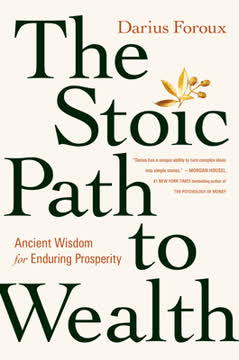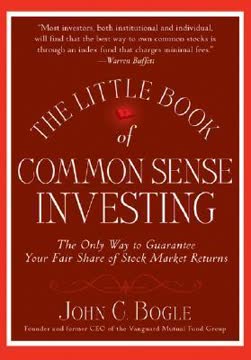Key Takeaways
1. Behavioral biases significantly impact investment decisions
"Because despite all of our modernity, learning, and market-focused technology, passions and emotions remain the most important aspect of investing."
Emotions drive decisions. Contrary to traditional economic theory, investors are not always rational. Behavioral biases, such as overconfidence, herding, and loss aversion, often lead to suboptimal investment choices. These biases are most pronounced during market turbulence, when emotions run high.
Understanding is key. Recognizing and accounting for these biases can significantly improve long-term investment results. By being aware of our tendencies to overreact to news, follow the crowd, or hold onto losing investments, we can make more rational decisions. This self-awareness is often more valuable than even a roaring bull market in determining investment success.
Context matters. Historical examples, from the South Sea Bubble to the dot-com boom, demonstrate how these biases have consistently influenced investor behavior over centuries. By studying these episodes, investors can better prepare themselves to avoid similar pitfalls in the future.
2. The disposition effect leads investors to sell winners and keep losers
"The disposition effect costs investors money."
Psychological drive. The disposition effect stems from the human desire to experience the pleasure of realizing a gain while postponing the regret of realizing a loss. This leads investors to sell stocks that have appreciated in value while holding onto those that have declined.
Counterproductive behavior. Research shows that stocks investors sell tend to outperform those they keep, resulting in lower overall returns. This behavior also has tax implications, as investors realize taxable gains while missing opportunities to harvest tax losses.
Overcoming the bias. To combat the disposition effect:
- Regularly review your portfolio based on future prospects, not past performance
- Set predetermined sell rules based on objective criteria
- Consider using automatic rebalancing tools to maintain desired asset allocation
3. Overconfidence causes investors to trade excessively and take undue risks
"Overconfidence among investors operates on many levels."
Illusion of knowledge. Investors often overestimate their ability to predict market movements and pick winning stocks. This leads to excessive trading, which incurs costs and typically results in underperformance compared to a buy-and-hold strategy.
Gender differences. Studies show that men, particularly single men, tend to be more overconfident in their investing abilities than women. This results in more frequent trading and lower returns on average.
Mitigating overconfidence:
- Keep a trading journal to track decisions and outcomes
- Regularly review and analyze your investment performance
- Seek out diverse perspectives and be open to conflicting viewpoints
- Consider using index funds or ETFs for core portfolio holdings
4. Herding behavior drives market bubbles and crashes
"Herding in the stock market is painful on the way up because the herd has overpaid; it is painful on the way down because responses are limited."
Safety in numbers. Humans have an innate tendency to follow the crowd, especially in uncertain situations. In investing, this leads to buying popular stocks or asset classes without proper analysis, driving prices to unsustainable levels.
Amplified extremes. Herding behavior exacerbates market bubbles and crashes. As more investors pile into a trending investment, prices become detached from fundamental values. When sentiment shifts, the stampede to exit can be equally dramatic.
Resisting the herd:
- Develop and stick to a well-defined investment strategy
- Focus on fundamental analysis rather than price momentum
- Be wary of investments touted as "can't-miss opportunities"
- Consider contrarian strategies when extreme sentiment prevails
5. Availability bias skews risk perception and investment choices
"Availability bias is the tendency to use the most easily recalled events to estimate the probability of something occurring rather than using a truer analysis of historical likelihoods or base rates."
Recency effect. Investors tend to give more weight to recent events and information, even if they are not representative of long-term trends. This can lead to overreaction to short-term market movements or news.
Misperception of risk. Dramatic or vivid events, such as market crashes, are more easily recalled than periods of steady growth. This can cause investors to overestimate the likelihood of extreme events and underestimate the probability of positive outcomes.
Countering availability bias:
- Regularly review long-term market data and historical trends
- Use quantitative tools to assess probabilities objectively
- Seek out diverse sources of information to broaden perspective
- Maintain a long-term focus in investment decision-making
6. Loss aversion prevents optimal risk-taking in investments
"Loss aversion leads investors to sell when the market dips because they have lost some money and the pain increases with each additional dollar lost."
Asymmetric impact. Research shows that the pain of losing money is about twice as strong as the pleasure of gaining an equivalent amount. This leads investors to be overly cautious and miss out on potentially profitable opportunities.
Short-term focus. Loss aversion often causes investors to evaluate their portfolios too frequently, leading to myopic decision-making. This can result in suboptimal asset allocation and reduced long-term returns.
Strategies to overcome loss aversion:
- Frame investment decisions in terms of long-term goals rather than short-term fluctuations
- Use dollar-cost averaging to reduce the impact of market timing decisions
- Set realistic expectations for portfolio volatility and prepare mentally for downturns
- Consider working with a financial advisor to provide objective guidance during market turbulence
7. Anchoring distorts valuation and decision-making in investing
"Anchoring is the mental bias that relies inappropriately on the first, available, or most recent information when making a decision."
Purchase price fixation. Investors often anchor to the price they paid for a stock, using it as a reference point for future decisions. This can lead to holding onto losing investments too long or selling winners too soon.
Arbitrary benchmarks. Price targets, historical highs or lows, and round numbers can all serve as anchors, influencing decisions without regard to fundamental value.
Mitigating anchoring bias:
- Regularly reassess investments based on current information and future prospects
- Use multiple valuation methods to determine fair value
- Set price targets and stop-loss orders in advance to reduce emotional decision-making
- Consider using limit orders to automate buying and selling decisions
8. Overreaction to news and events leads to market inefficiencies
"Investors overreact during crashes and bear markets."
Emotional amplification. Market participants tend to overreact to both positive and negative news, leading to excessive optimism in bull markets and undue pessimism in bear markets.
Opportunity in inefficiency. This overreaction creates opportunities for disciplined investors. Stocks that have been oversold due to negative sentiment often outperform in subsequent periods.
Managing overreaction:
- Develop a systematic approach to evaluating news and events
- Use dollar-cost averaging to take advantage of market volatility
- Consider contrarian strategies during periods of extreme sentiment
- Maintain a diversified portfolio to reduce the impact of individual stock movements
9. Social dynamics and emotions influence investment behavior
"Investing in speculative assets is a social activity."
Information exchange. Investors often discuss investments with friends, family, and colleagues, leading to the spread of both information and misinformation. This can contribute to herding behavior and the formation of market bubbles.
Emotional contagion. Moods and emotions can spread through social networks, influencing investment decisions. Euphoria during bull markets and panic during crashes can be amplified through social interactions.
Navigating social influences:
- Seek out diverse sources of information and opinion
- Be cautious of investment tips from non-professionals
- Develop a personal investment philosophy to guide decision-making
- Consider the motivations behind others' investment recommendations
10. Attention and salience bias affect stock selection
"Investors are more likely to buy shares in companies they've recently come across, regardless of the company's prospects, profits, or fundamental outlook."
Limited attention span. With thousands of stocks available, investors tend to focus on those that grab their attention through media coverage, unusual price movements, or high trading volume.
Familiarity bias. Investors often prefer stocks of companies they are familiar with, leading to suboptimal diversification and potential overvaluation of well-known firms.
Broadening investment horizons:
- Use screeners and other tools to identify potential investments systematically
- Consider index funds or ETFs to gain broad market exposure
- Regularly review and challenge your investment theses
- Be wary of investing based solely on recent news or price movements
11. Diversification and long-term thinking are crucial for successful investing
"Diversification is the only free lunch on Wall Street."
Risk reduction. A well-diversified portfolio can reduce overall risk without sacrificing potential returns. This is achieved by combining assets with low correlation, such as stocks and bonds.
Time horizon matters. The longer the investment horizon, the higher the probability of positive returns. Historical data shows that the odds of the stock market generating a positive return improve significantly as the holding period increases.
Implementing a successful strategy:
- Develop a diversified portfolio across asset classes, sectors, and geographies
- Regularly rebalance to maintain desired asset allocation
- Focus on long-term goals rather than short-term market fluctuations
- Consider using low-cost index funds or ETFs for core portfolio holdings
- Avoid timing the market and instead invest consistently over time
Last updated:
FAQ
What's The Anxious Investor about?
- Behavioral Focus: The Anxious Investor by Scott Nations delves into how emotions and behavioral biases impact investment decisions, emphasizing the importance of understanding these biases for better investment outcomes.
- Historical Analysis: The book examines significant financial bubbles and crashes, such as the South Sea Bubble and the Great Recession, to illustrate irrational investor behavior.
- Practical Guidance: Nations provides a checklist of fifteen common behavioral biases, helping readers recognize and mitigate these biases in their investing practices.
Why should I read The Anxious Investor?
- Improve Investment Outcomes: Understanding psychological factors that lead to poor investment decisions can enhance long-term financial results.
- Real-World Examples: Historical examples make the content relatable and applicable, showing how emotional responses can derail rational strategies.
- Actionable Strategies: The book offers practical strategies and checklists to help investors avoid common pitfalls, valuable for both novice and experienced investors.
What are the key takeaways of The Anxious Investor?
- Emotions Matter: Emotions play a crucial role in investing, often leading to irrational decisions that can harm financial outcomes.
- Behavioral Biases: Nations identifies fifteen specific biases, such as loss aversion and the disposition effect, that can negatively impact investment performance.
- Historical Lessons: Analyzing past market bubbles and crashes provides insights into recognizing and avoiding similar mistakes in the future.
What is loss aversion according to The Anxious Investor?
- Definition: Loss aversion is the psychological phenomenon where the pain of losing money is felt more intensely than the pleasure of gaining money.
- Behavioral Consequences: This leads to overly cautious behavior, causing investors to avoid risks that could lead to potential gains.
- Impact on Decision-Making: Nations highlights that loss aversion can cause investors to sell stocks during downturns, locking in losses instead of allowing time for recovery.
How does The Anxious Investor explain the disposition effect?
- Definition: The disposition effect is the tendency for investors to sell winning stocks too early while holding onto losing stocks for too long.
- Emotional Impact: Driven by the desire to realize gains and avoid the pain of losses, this behavior can lead to suboptimal investment decisions.
- Long-Term Consequences: This bias can significantly harm long-term returns, as investors may miss out on potential growth from winning stocks.
What is herding behavior as discussed in The Anxious Investor?
- Definition of Herding: Herding occurs when investors mimic the actions of others, often leading to irrational market movements.
- Psychological Underpinnings: The desire for social acceptance and belief that others are better informed can drive this behavior.
- Consequences: Herding can result in buying overvalued stocks and selling undervalued ones, ultimately harming investment returns.
How does The Anxious Investor address information overload?
- Definition: Information overload occurs when investors are bombarded with too much information, making it difficult to make informed decisions.
- Effects on Decision-Making: During market volatility, reacting to every piece of news can lead to hasty decisions.
- Strategies to Manage: Nations suggests focusing on key metrics and maintaining a disciplined strategy to avoid being overwhelmed.
What role does fear play in investing according to The Anxious Investor?
- Fear as a Driving Force: Fear can lead to irrational decision-making, especially during market downturns, causing investors to panic and sell at the worst times.
- Historical Context: The book examines how fear influenced behavior during significant market crashes, illustrating its detrimental effects.
- Mitigating Fear: Understanding fear's role can help investors develop strategies to remain calm and rational in volatile conditions.
How does The Anxious Investor suggest improving investment decision-making?
- Awareness of Biases: Being aware of one’s own behavioral biases and emotional triggers can lead to more rational decision-making.
- Use of Checklists: The book includes a checklist of biases and strategies to help investors evaluate decisions and avoid pitfalls.
- Long-Term Focus: Nations encourages maintaining a long-term perspective and resisting impulsive reactions to short-term fluctuations.
What role does diversification play according to The Anxious Investor?
- Importance of Diversification: Diversification is key for reducing risk and enhancing returns, spreading investments across various asset classes.
- Risk Management: This strategy helps mitigate the impact of poor performance in any single investment, creating a more stable portfolio.
- Long-Term Benefits: A well-diversified portfolio is more likely to withstand market fluctuations and achieve better long-term results.
What are some common behavioral biases identified in The Anxious Investor?
- List of Biases: Nations identifies fifteen biases, including the disposition effect, loss aversion, overconfidence, and herding behavior.
- Understanding Biases: Recognizing these biases is crucial to avoid making emotional decisions that can lead to poor financial outcomes.
- Practical Application: The book provides a checklist to help investors assess their susceptibility and develop strategies to counteract them.
What are the best quotes from The Anxious Investor and what do they mean?
- “I can calculate the motions of the heavenly bodies, but not the madness of the people.”: Highlights the limitations of rational analysis in the face of human emotions and irrational behavior.
- “The real key to making money in stocks is not to get scared out of them.”: Emphasizes maintaining composure and a long-term perspective during market downturns.
- “Investing is about making money.”: Serves as a foundation for exploring how emotional and psychological factors can derail that goal.
Review Summary
The Anxious Investor receives mixed reviews, with an average rating of 3.54 out of 5. Readers appreciate the historical context of market crashes and psychological insights into investor behavior. However, many find the content repetitive and lacking in specific investment advice. Some praise the book's engaging writing and focus on mental aspects of investing, while others criticize its verbosity on market history. The book is generally seen as more suitable for novice investors, with experienced readers finding little new information. Overall, the book's main message emphasizes diversification and long-term thinking.
Similar Books










Download PDF
Download EPUB
.epub digital book format is ideal for reading ebooks on phones, tablets, and e-readers.




